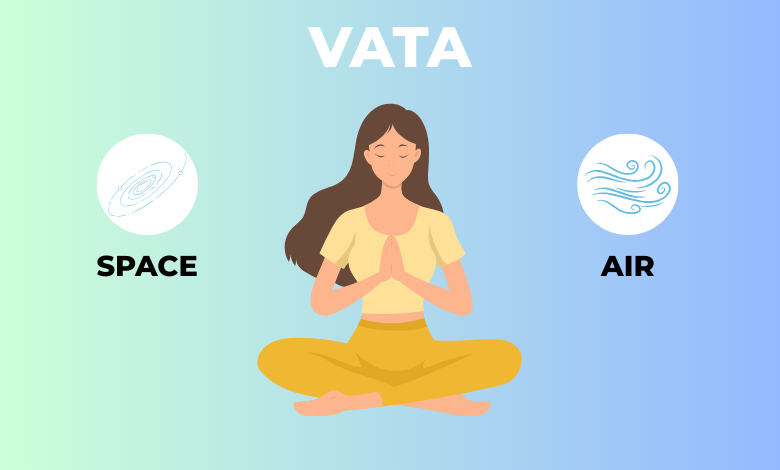Have you ever wondered why some days you feel energetic and creative, while on others you feel scattered and restless? In Ayurveda, these patterns are often linked to Vata Dosha — the energy of movement, air, and space within us.
In this blog, we’ll explore everything about Vata Dosha, from understanding the Vata body type to simple ways you can balance this lively yet delicate energy through diet, lifestyle, and daily habits.
What exactly is Vata Dosha in Ayurveda?
In Ayurveda, our bodies are made up of three doshas — Vata, Pitta, and Kapha. Each person has a unique blend of all three, but usually, one or two doshas are more dominant.
Vata is the energy of movement and change. It’s connected to lightness, dryness, coolness, and mobility.

If you have a Vata-dominant constitution (or Vata body type), you might notice you have a thin frame, dry skin, and a quick, creative mind. People with a Vata nature are often energetic and enthusiastic but can also easily get overwhelmed, anxious, or scattered.
Understanding your body type helps you make choices that support your health — which brings us to the importance of balancing Vata.
How can you tell if your Vata is out of balance?
When Vata is in harmony, it brings creativity, joy, and clear communication. But when there’s a Vata imbalance, you might start noticing some not-so-fun symptoms like:
- Feeling anxious, restless, or worried
- Having trouble sleeping or waking up frequently at night
- Experiencing dry skin, constipation, or irregular digestion
- Feeling cold often, especially in the hands and feet
- Getting easily fatigued or mentally drained
The thing about Vata is — because it’s so light and mobile — it can quickly go out of balance if we’re not mindful, especially during Rainy and early winter, when the environment becomes dry and cold too.
Luckily, Ayurveda gives us lots of beautiful tools to bring that airy energy back to earth.
How to bring your Vata Dosha back into balance
The golden rule for Vata balance is simple: think warm, soft, grounding, and steady.
When Vata gets too high, we need to slow down, warm up, and nourish ourselves — both physically and emotionally.
Here’s what helps:
Stick to a daily routine:
Vata thrives on stability. Try to wake up, eat, and go to bed at the same times every day.
Keep yourself warm:
Dress in cozy layers, drink warm herbal teas, and favor hot meals over cold foods.
Incorporate grounding exercises:
Gentle yoga, stretching, and calming walks in nature can work wonders.
Indulge in oil massages:
Daily self-massage with warm sesame oil can deeply nourish dry skin and calm a restless mind.
Prioritize rest:
Vata types tend to burn out easily. Rest is not a luxury for you — it’s a necessity.
Remember, even small daily practices can make a big difference over time.
What does a Vata Dosha diet look like?
When it comes to food, Vata needs nourishment that is warm, moist, and easy to digest. A Vata dosha diet focuses on creating internal warmth and moisture to counter Vata’s natural dryness and coldness.
Here are some food ideas that form the foundation of a Vata balancing diet:
- Enjoy warm, cooked meals like soups, stews, and porridges.
- Include healthy fats like ghee, white butter, and milk to keep your body lubricated.
- Favor sweet, sour, and salty tastes — they are grounding for Vata.
- Use warming spices like oil or ghee in your cooking with a small amount of ginger, garlic ,cinnamon, cumin, and cardamom in your cooking.
- Choose cooked seasonal vegetables over raw salads, especially root vegetables like carrots, sweet potatoes, and beets.
And what should you avoid? Well, try to minimize dry snacks like crackers and popcorn, carbonated drinks, raw veggies, bakery products, sprouts and too much caffeine — all these can aggravate Vata and make you feel even more scattered.
Living happily with a Vata body type
If you identify strongly with the Vata body type, you probably already know how wonderful it can feel when you’re in balance — full of fresh ideas, quick to adapt, light-hearted, and vibrant.
To maintain that spark, it’s important to build a lifestyle that supports your nature:
- Carve out time for relaxation every day, even if it’s just a few minutes of quiet breathing.
- Surround yourself with calming, soft environments — soft lighting, warm colors, cozy textures.
- Listen to your body when it signals that it needs rest or nourishment.
- Be kind to yourself during periods of low energy; it’s natural for Vata types to have ups and downs.
Small lifestyle choices really add up when it comes to maintaining your natural rhythm.
The Ayurvedic view: Why Vata Dosha matters so much
In Ayurveda, Vata is often called the “king of the doshas” because it governs all movement in the body — from the heartbeat to the communication between cells.
When Vata gets disturbed, it can quickly throw the other two doshas, Pitta and Kapha, off balance as well.
That’s why maintaining Vata balance is often seen as the first and most crucial step toward lasting health.
Tapasya Health provides you with all necessary ayurvedic and naturopathy treatments for health conditions related to Vata Dosha. Book your online ayurvedic consultation!
Whether it’s through a nourishing Vata dosha diet, calming routines, or staying connected to warmth and comfort, balancing your Vata can be life-changing.